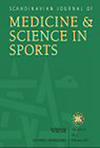男性足球运动员长期腹股沟疼痛和无症状控制的耻骨相关放射检查结果-它们是否具有临床相关性?
IF 3.8
2区 医学
Q1 SPORT SCIENCES
引用次数: 0
摘要
asppetar耻骨联合影像学评分方案在男性足球运动员中是可靠的,但其临床意义尚不清楚。我们调查了男性足球运动员和无症状对照组中与耻骨相关的x线表现的患病率及其与腹股沟疼痛和残疾的关系。我们纳入了39名有长期腹股沟疼痛症状的男性足球运动员,18名无症状的男性足球运动员和20名无症状的男性非足球运动员。由两名放射科医生分析站立骨盆正位x线片中与耻骨相关的骨透明度、增生、硬化、碎裂和关节间隙宽度(JSW,毫米)。结果合并成耻骨联合放射学严重性评分(PSRS评分,0-8)。采用五秒挤压试验(5SST, 0-10)和髋关节和腹股沟结局评分(HAGOS, 100-0)测量腹股沟疼痛和残疾。对于有症状的足球运动员、无症状的足球运动员和无症状的非足球运动员,耻骨相关x线检查的患病率分别为:骨透光率:87%、83%和40%;增殖:67%,61%,25%;硬化:64%,50%和15%;碎片:15%,6%和0%,而三组的平均JSW为3 mm。有症状和无症状的足球运动员在任何发现上没有差异(p≥0.39)。足球运动员比非足球运动员更容易出现骨透光、增生和硬化(p < 0.002)。PSRS评分与5SST、HAGOS相关性较差。总之,与耻骨相关的x线检查结果与腹股沟疼痛或残疾无关。与男性非足球运动员相比,男性足球运动员的耻骨相关放射检查结果更为常见。本文章由计算机程序翻译,如有差异,请以英文原文为准。
Pubic-Related Radiographic Findings in Male Football Players With Long-Standing Groin Pain, and Asymptomatic Controls - Are They Clinically Relevant?
The Aspetar pubic symphysis radiographic scoring protocol is reliable in male football players, but its clinical significance is unclear. We investigated the prevalence of pubic-related radiographic findings and their association with groin pain and disability in male football players and asymptomatic controls. We included 39 symptomatic male football players with long-standing groin pain, 18 asymptomatic male football players, and 20 asymptomatic male non-football athletes. Standing anteroposterior pelvic radiographs were analyzed by two radiologists for pubic-related bone lucency, proliferation, sclerosis, fragmentation, and joint space width (JSW, millimeters). Findings were combined into a Pubic Symphysis Radiographic Severity Score (PSRS Score, 0-8). Groin pain and disability were measured using the Five-Second Squeeze Test (5SST, 0-10) and the Hip and Groin Outcome Score (HAGOS, 100-0). For symptomatic football players, asymptomatic football players, and asymptomatic non-football athletes, the pubic-related radiographic findings prevalence's were, respectively: bone lucency: 87%, 83%, and 40%; proliferation: 67%, 61%, and 25%; sclerosis: 64%, 50%, and 15%; and fragmentations: 15%, 6%, and 0%, while the mean JSW was 3 mm in all three groups. There were no differences between symptomatic and asymptomatic football players in any findings (p ≥ 0.39). Bone lucency, proliferation, and sclerosis were more frequent in football players than non-football athletes (p < 0.002). PSRS Score showed poor correlation with 5SST and HAGOS. In conclusion, pubic-related radiographic findings are not associated with groin pain or disability. Pubic-related radiographic findings are more common in male football players than male non-football athletes.
求助全文
通过发布文献求助,成功后即可免费获取论文全文。
去求助
来源期刊
CiteScore
7.90
自引率
4.90%
发文量
162
审稿时长
3 months
期刊介绍:
The Scandinavian Journal of Medicine & Science in Sports is a multidisciplinary journal published 12 times per year under the auspices of the Scandinavian Foundation of Medicine and Science in Sports.
It aims to publish high quality and impactful articles in the fields of orthopaedics, rehabilitation and sports medicine, exercise physiology and biochemistry, biomechanics and motor control, health and disease relating to sport, exercise and physical activity, as well as on the social and behavioural aspects of sport and exercise.

 求助内容:
求助内容: 应助结果提醒方式:
应助结果提醒方式:


